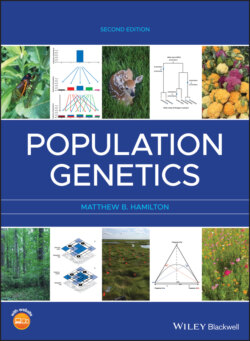Читать книгу Population Genetics - Matthew B. Hamilton - Страница 16
1.2 Theory and assumptions
ОглавлениеWhat Is a Theory and What Are Assumptions?
How Can Theories Be Useful with So Many Assumptions?
In colloquial usage, the word theory refers to something that is known with uncertainty, or a quantity that is approximate. On a day you are running late leaving work, you might say, “In theory, I am supposed to depart at 6:00 pm.” In science, theory has a very different meaning. Theory is the accumulation of expectations and observations that have withstood tests and critical scrutiny and are accepted by at least some practitioners of a scientific field. Theory is the collection of all of the expectations developed for specific cases or individual biological processes that together form a more comprehensive set of general principles. The combination of Darwin's hypothesis of natural selection with the laws of Mendelian particulate inheritance is often called the modern synthesis of evolutionary biology since it is a comprehensive theory to explain the causes of evolutionary change. The modern synthesis can offer causal explanations for biological phenomena ranging from antibiotic resistance in bacteria to the behavior of elephants to the rate of DNA sequence change, as well as make predictions to guide animal and plant breeders. In all of the modern synthesis, population genetics plays a central role.
It is common for the uninitiated to ask the question “what good is theory if it is based on so many assumptions?” A body of theory is a useful tool to articulate assumptions and generate testable predictions. Theory that generates many testable predictions about the world also offers many opportunities to falsify its predictions and assumptions. Since hypotheses cannot be proven directly, but alternative hypotheses can be disproven, the generation of plausible, testable alternative hypotheses is a requirement for scientific inquiry. Strong theories are able to make accurate predictions, offer causal explanations for diverse observations, and generate alternative hypotheses based on revised assumptions.
The words theory and assumption can seem abstract, but you should not be intimidated by them. Theories are just collections of expectations, each with a set of assumptions that place bounds on the prediction being made. If you understand what motivates an expectation, its predictions, and its assumptions, then you understand theory. Most expectations in population genetics will have at least a few, and often many, assumptions used to define and bound the situation. For example, we might assume something about the size of a population or the absence of mutation, or that all genotypes are diploid with two alleles. This is a way of limiting the prediction to appropriate circumstances and a way of defining which quantities and conditions can vary and which are fixed. Each of these assumptions can influence the generality of an expectation. Each assumption can also be relaxed or altered to see how strongly it influences the expectation. To return to the example in the preceding section, if, one day, meteorites start falling around us with regularity, we would be forced to call into question some of the basic assumptions originally used to formulate our expectation that meteorite strikes should be rare events. In this way, assumptions are useful tools to ask “what if…?” as part of the process of developing a prediction. If our initial “what if…?” conditions do not match a situation, then the resulting prediction will probably be inaccurate.
In population genetics, as in much of science where theory and expectations are involved, empirical data and model expectations are routinely compared. Imagine observing a set of genotype frequencies in a biological population. It would then be natural to construct an idealized population by using theory that approximates the biological population. This is an attempt to construct an idealized population that is equivalent to the actual population from the perspective of the processes influencing genotype frequencies. For example, a large population may behave exactly like a small, randomly mating ideal population in terms of genotype frequencies. This equivalence allows us to use expectations for ideal populations with one or a few variables specified in order to describe an actual population where there are many more, usually unknown, parameters. What we strive to do is to focus on those variables that strongly influence genotype frequencies in the actual population. In this way, it is often possible to reduce the complexity of a real population and determine the key variables that strongly influence a property like genotype frequencies. The ideal population is not meant to match the actual population in every detail.
Theory: A scheme or system of ideas or statements held as an explanation or account of a group of facts or phenomena; the general laws, principles, or causes of something known or observed.
Infer: To draw a conclusion or make a deduction based on facts or indications; to have as a logical consequence.
From the comparison of expectation and observation, we infer that the first principles used to construct the expectation are sound if they can be used to explain patterns observed in the biological world. However, there is a major distinction between considering an actual and idealized population equivalent and considering them identical. This is seen in cases where the observed pattern in an actual population is consistent with the expectations from several model populations built around distinct and incompatible assumptions. In such cases, it is not possible to infer the processes that cause a given pattern without additional information. A common example in population genetics are cases of genetic patterns that are potentially consistent with the random process of genetic drift and, at the same time, consistent with some form of the deterministic process of natural selection. In such cases, unambiguous inference of the underlying cause of a pattern is not possible without additional empirical information or more precise expectations.
